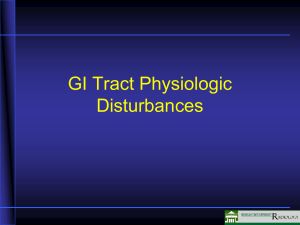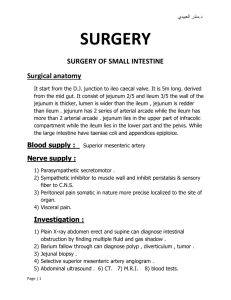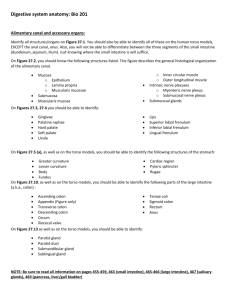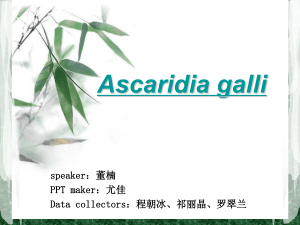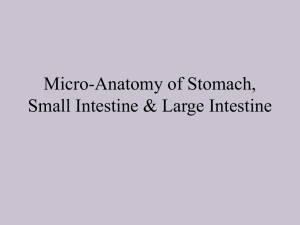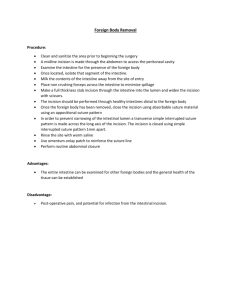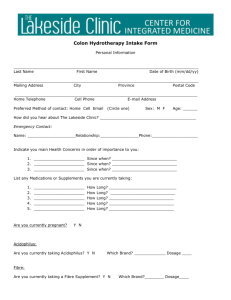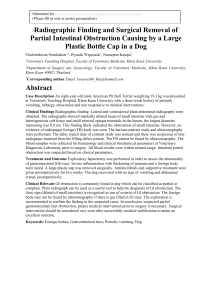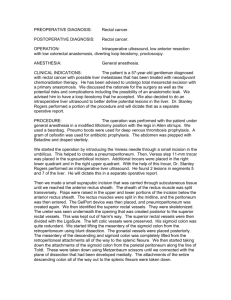Treatment
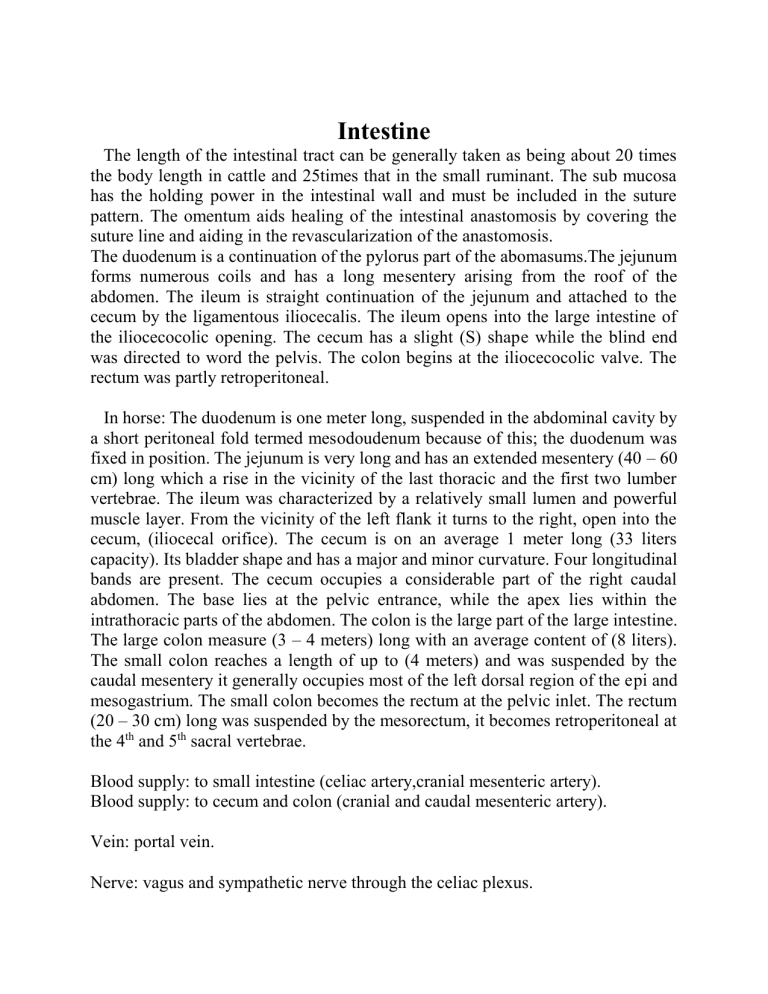
Intestine
The length of the intestinal tract can be generally taken as being about 20 times the body length in cattle and 25times that in the small ruminant. The sub mucosa has the holding power in the intestinal wall and must be included in the suture pattern. The omentum aids healing of the intestinal anastomosis by covering the suture line and aiding in the revascularization of the anastomosis.
The duodenum is a continuation of the pylorus part of the abomasums.The jejunum forms numerous coils and has a long mesentery arising from the roof of the abdomen. The ileum is straight continuation of the jejunum and attached to the cecum by the ligamentous iliocecalis. The ileum opens into the large intestine of the iliocecocolic opening. The cecum has a slight (S) shape while the blind end was directed to word the pelvis. The colon begins at the iliocecocolic valve. The rectum was partly retroperitoneal.
In horse: The duodenum is one meter long, suspended in the abdominal cavity by a short peritoneal fold termed mesodoudenum because of this; the duodenum was fixed in position. The jejunum is very long and has an extended mesentery (40 – 60 cm) long which a rise in the vicinity of the last thoracic and the first two lumber vertebrae. The ileum was characterized by a relatively small lumen and powerful muscle layer. From the vicinity of the left flank it turns to the right, open into the cecum, (iliocecal orifice). The cecum is on an average 1 meter long (33 liters capacity). Its bladder shape and has a major and minor curvature. Four longitudinal bands are present. The cecum occupies a considerable part of the right caudal abdomen. The base lies at the pelvic entrance, while the apex lies within the intrathoracic parts of the abdomen. The colon is the large part of the large intestine.
The large colon measure (3 – 4 meters) long with an average content of (8 liters).
The small colon reaches a length of up to (4 meters) and was suspended by the caudal mesentery it generally occupies most of the left dorsal region of the epi and mesogastrium. The small colon becomes the rectum at the pelvic inlet. The rectum
(20 – 30 cm) long was suspended by the mesorectum, it becomes retroperitoneal at the 4 th and 5 th sacral vertebrae.
Blood supply: to small intestine (celiac artery,cranial mesenteric artery).
Blood supply: to cecum and colon (cranial and caudal mesenteric artery).
Vein: portal vein.
Nerve: vagus and sympathetic nerve through the celiac plexus.
Specific surgical conditions of the small intestine
:
Ι.
Simple obstruction
: The severity of clinical signs associated with a simple obstruction of small intestine depends on the degree of obstruction complete or incomplete and the level of the obstruction proximal (pylonic, duodenal or jejunal) or distal obstruction (ileum or colon). Complete and proximal shows more traumatic clinical signs. Obstruction leads to sequestration of fluid and electrolyte causing bowel distension and pain.
The etiology of obstruction:
1.
Ascarid impaction
: Occur in young horses up to one year of age with heavy hurdens of Parascaris equorum. Obstruction usually occurs shortly after anthelminic treatment. Rupture of the intestine can result in severe cases.
Clinical signs
:
a.
Pain. b.
Gastric reflex. c.
Hemoconcentration associated with fluid sequestration.
It has been suggested that dead ascarid cause a toxic or allergic effect which may exacerbate any systemic deterioration.
Treatment : Enterotomy for complete obstruction or any obstruction that has not responded to administration of mineral oil.
2.
Adhesion
: Are common sequel to peritonitis or abdominal surgery fibrinous exudate was produced by inflamed peritoneum and subsequent organization can lead to a non-elastic band or stricture, such lesions cause compromise of the lumen of the bowl. Adhesion can also result from acute
Strongylus vulgaris infection. Adhesion may also lead to a strangulating obstruction.
Clinical signs
:
a.
Recurrent colic. b.
Intestinal distension and fluid reflex.
Treatment: In mild cases separation of adhesion but in severe cases make intestinal resection and anastomosis.
3.
Pedunculated lipoma
: of the mesentery may cause simple obstruction they commonly cause strangulation obstruction. Lymphisarcoma may be seen involving the abdomen particularly the mesenteric lymph node. Sq. cell carcinoma cans metastasis throughout the abdomen.
Treatment : Resection and anastomosis.
4.
Foreign body
: In cattle sheep and goat a zootrichobezoar or phytotrichobezoar forms around a center of hair, wool or vegetable fiber.
This may happen more often in calves; due to lick each other and themselves continuously and thus ingest large quantities of hair which eventually form a zootrichobezoar. In dogs foreign bodies are the most common cause of intestinal obstruction in young dogs, partially digested bones cause obstruction in the colon.
Clinical signs: a.
Vomiting. b.
Depression. c.
Anorexia. d.
Abdominal pain. e.
Palpable abdominal mass.
Treatment: Enterotomy.
5.
Muscular hypertrophy of the ileum
: Muscular hypertrophy of the muscles of the distal ileum (at the iliocecal valve) may cause intestinal obstruction. The condition has been associated with stenosis of the ileum secondary to a mucosal lesion, strongle larval migration and neurogenic stenosis with prolonged closure of the iliocecal valve.
D.D.: Spasm of iliocecal valve.
Treatment: Ilealmyotomy and iliocecal anastomosis.
6.
Abdominal abscess
: May produce compression or stricture of a portion of small intestine. The majority of abdominal abscess involve the mesentery.
Systemic spread from respiratory infection was considered. Most common cause of abdominal abscess in addition to umbilical infection.
Clinical signs
:
a.
Prolonged colic. b.
Weight loss.
c.
Marked depression and anorexia. d.
Decrease gut motility. e.
Dehydration. f.
Mass can be palpated on rectal examination.
Diagnosis : a.
Clinical signs. b.
Clinicopathological findings. c.
Peritoneal fluid (Exudate).
Treatment : a.
Long term penicillin administration has been used successfully. b.
Surgical treatment can be drain intraoperatively or marsupialized without peritoneal contamination. c.
Resection and anastomosis.
7.
Diverticulosis of jejunum, stagnation of intestinal content in a diverticulum can cause obstruction.
8.
Atresia ilei : A hereditary the fetus have greatly enlarged abdomen and are born (1 – 2 months) prematurely, the distal part of the ileum is atretic.
9.
Duodenitis syndrome : Clinical signs of a simple proximal obstruction of the small intestine.
Clinical sings
:
1voluminous reflex of fluid on stomach tube.
2Hemoconcentration.
Diagnosis :
1clinical signs.
2Laparotomy (thickness edematous duodenum).
Treatment : Duodenocecostomy (right lateral approach to the abdominal)
Removing the last rib to provide access to both the duodenum and base of cecum.
10.
Duodenal stenosis
: congenital or traumatic.
Clinical sings
:
1Recurrent dysphagia
2Salivation.
3Depression and anorexia.
4Esophagitis (acidic reflex).
5Intermittent colic.
Diagnosis : Contrast radiography.
Treatment : Surgically, a longitudinal enterotomy incision was performed and closes in a transverse fashion. a.
Linea alba incision under general anesthesia from the xiphoid cartilage caudally. b.
The stenosis part brings it to the surface of abdominal wound. c.
Make a longitudinal incision in the stenosis part and suture transversely with
(3 – 6 chromic catgut) using Connell or Cushing suture. d.
Close the abdominal wall.
11.
Embryonic anomalies
: Two embryonic abnormalities that may lead to small intestinal obstruction condition: a.
Meckel's diverticulum
: Result from persistence of a portion of omphalomesentric duct which was usually obliterated and disappear.
Projecting from the antimesentric surface of ileum with a fibrous band connecting the diverticulum to abdominal wall in the area of umbilicus.
The lumen of diverticulum communicates with the lumen of ileum.
Treatment: Surgical removal of band and diverticulum. b.
Mesodiverticular bands
: Was formed by persistence of a distal segment of a vitelline artery and its associated embryonic mesentery. The band extends from one side of the small intestinal mesentery to the antimesentric surface of the intestine. A triangular hiatus was formed between the Mesodiverticular bands. Jejunal mesentery and jejunum entrapment of intestine in this hiatus can cause herniation of intestine through jejunal mesentery and secondary volvulus.
Treatment : Reduction of strangulation or volvulus, then intestinal resection and anastomosis if needed and close ring.
In all these of obstruction thy effect of intestinal lumen without vascular compromise initially the integrity of the mucosal barrier remain intact. In general the obstruction of small intestine may be: a.
Extraluminal obstruction associated with constructive fat necrosis, abscess, adhesion, acute enlargement of lymphatic tissue, hemorrhage in the mesentery as a result of external trauma . b.
Intraluminal obstruction associated with foreign body such as phytobezoars entered small intestine from the abomasum.
Π. Strangulation
obstruction
: Characterized by simultaneous interference of the intestinal blood vessels and blockage of intestinal lumen.
A.
Intussusception
:
Is the invagination of a segment of intestine and its mesentery into the adjacent distal segment of bowel. The small intestine is most common site of occurrence for this condition, involving the jejunum, ileum or terminal ileum. Any factors that alter intestinal motility could therefore lead to development of the condition.
Etiology:
1.
Heavy ascarid infection.
2.
Sudden dietary changes.
3.
Enteritis.
4.
Mesenteric arteritis.
5.
Simple obstruction.
6.
Previous enterotomy.
7.
Intestinal irritation associated with canine distemper or parasitism.
8.
Ingestion of large quantities of food and fluid may lead to excessive gas formation, provoking vigorous motility in one segment of intestine and passive distension and the segment immediately succeeding it.
9.
Local intestinal distortion as a result of carcinoma or a localized thickening of the intestinal wall following a vascular lesion.
Clinical signs
:
1.
Colic.
2.
Stretching posture.
3.
Failure to defecate.
4.
Anorexia.
5.
Decrease or no gut sound.
6.
Dark blood and stained mucous in rectum.
7.
Vomiting in dog.
8.
If obstruction incomplete, the clinical signs (Anorexia , Depression and moderate abdominal pain).
Diagnosis :
1.
Rectal examination, sausage like swelling.
2.
X – Rays.
3.
Laporatomy.
4.
Change of peritoneal fluid.
Treatment :
1.
Reduction of Intussusception or.
2.
Resection and anastomosis.
B.Volvulus
Is produced by 180° or greater rotation of a segment of jejunum or ileum about the long axis of the mesentery. Rotation of up to 180° may occur physiologically without producing disturbance.
Etiology
:
1.
primary displacement
2.
secondary to a preexisting lesion such as :-
1 -Incarceration in mesentery.
2 -Epiploic foramen.
3 -gastrosplenic omentum.
4 -mesodiverticular bands.
5 -meckels diverticulum.
6 -Adhesion.
7 -Infarction.
8 -Ascarid impaction or strongyle migration.
9 -Dietary change.
In such cases it is thought that such an obstruction or area of decrease motility provides affixed for the bowel to twist around. The strangulation primarily affects the vein so that the ischemia state was characterized by venous congestion.
Clinical signs
:
1.
Loss of gut motility proceeding to complete ileus.
2.
Gas distension in intestine.
3.
Intense pain.
4.
Rapid and weakening pulse.
Diagnosis :
1.
Rectal examination will reveal distended and thickness of loop of bowel.
2.
Peritoneal fluid, sanguineous in appearance.
Treatment
:
1.
Reduction: Under G.A. make an incision along the linea alba. The twist was reduced by passing a finger carefully through the primary loop to allow movement of secondary loop if necessary gas can be released by putting a purse string suture into the wall of bowel and passing a thick needle.
2.
Resection and anastomosis.
C.Incarceration
Internal hernia of small intestine usually result incarceration. Internal hernia through pathological opening is more common and includes mesenteric defect, tear in omentum, defect in broad ligament and through foramen formed by fibrous band, adhesion or lipoma. Also incarceration may occur with umbilical hernia. The herniated piece of intestine can become incarcerated and strangulated by the hernial ring.
Clinical signs:
Signs are typical of strangulation obstruction they will generally be more severe, if there is an associated volvulus.
Treatment: Make laparotomy, reduction of herniated piece, suture the ring, or in severe cases make resection and anastomosis of herniated part.
None strangulated infarction
Infarction of intestine that is unassociated with strangulating. This condition has usually been classified as thromboembolic colic. Thrombotic disease in the mesenteric vasculature has been associated with Strangles vulgarus larval migration or the resulting of arteritis.
1.
Thrombosis of the cranial mesenteric and ileocecolic artries are the primary cause.
2.
Vascular spasm or increased pressure in the intestinal wall secondary to obstructive lesion.
3.
Anemia infarction may be anticipated following arterial occlusion.
Clinical signs:
1 . Minimal bowel distension.
2 . Moderate pain.
3 . Gastric reflex.
Diagnosis
:
1.
Clinical signs.
2.
Peritoneal fluid yellow orange.
3.
Rectal examination.
Treatment
:
Intestinal resection and anastomosing is the only effective treatment with infracted intestine.
Postoperative small intestinal problem
Paralytic ileus is common complication following intestinal surgery to minimize this:
1.
Minimal trauma.
2.
Fast surgery.
3.
Aseptic technique.
4.
Avoidance of irritation to the peritoneal cavity.
Enterotomy: Transverse or longitudinal incision to the long axis of the bowel.
The closure of the wound was done by one layer or two layers.
Enteroctomy : Resection (portion of intestine) was performed after ligating the vessels in the mesentery with supply the resected site.
In enterotomy closure of wound by simple interrupted in one layer or Connell and lembert in two layers. While in Enteroctomy the two ends were closed by inverted or everted technique by using horizontal mattress suture or vertical mattress suture or by using Connell and Cushing or Connell and lembert in two layers.
Many variations of anastomosis a ligament such as:
1.
End to end.
2.
End to side.
3.
Side to side.
The decision to excise has been based on:
1.
Color.
2.
Presence of peristalsis.
3.
Pulsation of mesenteric vessels to the segment.
Indications of intestinal resection:
1.
Gangrene of intestine due to loss of blood supply as in intestinal strangulation.
2.
Injury to intestinal wall or tear in mesentery along the intestinal mesenteric border.
3.
Obstruction.
4.
Irreducible intussusception.
5.
Neoplasia.
6.
Intestinal infarction.
•
•
•
Megacolon: Megacolon is a functional disorder that is defined as dilatation of the colon or large intestine; this leads to infrequent and difficult passage of feces and constipation
There are congenital forms which are present from birth
The acquired form is most common
Megacolon is found primarily in cats, but also can occur in dogs
•
•
Causes of megacolon
• Dietary and environmental factors such as foreign bodies in the colon, lack of exercise.
Painful defecation due to anal sac abscess or stricture of the anus
Narrowed pelvic canal o Due to previous fracture of the pelvis o
•
•
Intrapelvic tumors
Neurologic disease which results is the inability to posture for bowel movements.
Idiopathic – unknown cause is most common
• Note: Normally cats can retain feces in the colon for a period of several days without harm; if the passage of feces is prevented the colon becomes distended; the duration and degree of constipation necessary to cause megaconlon is unknown
•
•
•
•
•
•
•
•
Clinical signs
•
•
Passage of smaller stools than normal
Less frequent defecation
Straining to defecate
Systemic signs
Lack of appetite
Depressed attitude
Thin
Dehydration
Vomiting
Anemia
o o
Diagnosis:
• Occasionally the history and physical examination are enough to diagnose megacolon, but other tests are important to identify a potential cause
• Rectal palpation may help to identify problems with the anus or pelvis that may be causing the constipation
•
X-rays of the pelvis and abdomen are routinely taken
Treatment options
• Conservative o Stool softeners and lubricating agents
Cleansing enemas
Manual removal of stool o
• o o Dietary modification (increased fiber diet) o Drugs to increase motility o f the colon (cisapride…which recently has become not available)
When conservative therapy is not effective surgery is recommended
Surgery
Removal of the colon o The end of the small intestine is connected to the rectum
•
•
•
•
Postop care
• Antibiotics are given short term after surgery
Pain medication is usually needed for a couple of days
All laxatives are usually stopped
Highly digestible food.
Limit exercise for 3 weeks
• Watch for signs of infection
Rectum
The rectum extends from pelvic inlet to the anus. The cranial segment was covered in peritoneum and was suspended by a continuation of mesocolon
(mesorectum). The caudal portion is retroperitoneal and forms flask shape dilation (ampulla recti) this portion was attached to surrounding structures by c.t and muscular bands. Bl.S of the terminal small colon and rectum consist of the cranial hemorrhoidal branch of the caudal mesenteric artery and the middle and caudal hemorrhoidal branches of the internal pudendal artery.
Rectal Tear
1. Rough rectal palpation during examination.
2. Weakness in the rectal duct degeneration in association with disease of previous rectal injury.
3. Forced extraction of fetuses of parturition.
4. Rectal infarction and neoplasia.
Classification of rectal tears:
1. Tears involve mucosa or submucosa. Treated by suture through the anus under epidural analgesia or the patient was placed on antibiotic and mineral oil.
2. Rupture of muscular layer, whereas the mucosa, sub mucosa and serosa remain intact.
3. Tears involve mucosa, submucosa and muscular layers. Tear into the retroperitoneal portion of the rectum cause cellulitis and abscessation, whereas in the peritoneal region can lead to peritonitis. Treated by suture the tear via laparotomy or per rectum.
4. Tear involve all layers, these produce immediate contamination and acute peritonitis unless there is immediate surgical treatment endotoxic shock and death usually result. Treatment by colostomy if the tear is small and treatment was instituted early enough before gross contamination of peritoneal cavity has occurred.
Procedure : Make small opening in right flank, pull colon and suture with muscle then make incision in protruded part of colon, then close the edge of colon with skin.
Complications of colostomy:
1. Stenosis of an aperture.
2. Leak lead to peritonitis and death.
Rectal prolapse
Classified into:
1. Mucosal prolapse: Usually present as a circular swelling at the anus resulting from submucosa and mucous membrane protruding caudally.
2. Complete prolapse: Usually larger and more cylindrical and involves all or apportion of the ampulla recti.
3. Complete prolapse with invagination of colon, if invagination of the colon will be firm and thickness.
Etiology:
1. Any condition that causes tenesmus including: a. constipation. d. proctitis. g. dystocia. b. diarrhea. e. intestinal parasitism. h. urethral obstruction. c. enteritis. f. rectal foreign body. I. colic.
2. Predisposing factors including loss of anal sphincter tone, and loss attachment of the rectum to per rectal tissue.
Treatment:
1.
Epidural anesthesia to prevent further straining, manual reduction of the prolapse, then use purse string suture in the anus maintain retention.
2. Sub mucosal resection.
3. Amputation of the rectum becomes necessary in prolonged cases of prolapse with severe necrosis or damage of rectal tissue. This procedure was done be placing a horizontal mattress sutures around the site of the amputation before excision of the prolapsed tissue.
Complication s: a. Dehiscence of the suture line. b. Stricture may develop at the surgical site. c. peritonitis. d. death.
Atresia ani:
Atresia of the anus sometimes occur if the space between the anus and rectum is small, it is possible to exteriorized the rectum and make an artificial anus but if the gap in great a colostomy procedure could be considered.
Clinical signs : Straining at defecation.
Diagnosis : Pressure on the abdomen will cause the blind end of the rectum to bulge of the anal site.
Treatment : Acicular piece of skin was excised over the bulge or small longitudinal incision over the bulge or cross incision. Blunt dissection to reach the ampulla of rectum, then pull it and open. Then suture the mucosa of rectum with skin by simple interrupted using silk.
Atresia recti:
Absent of rectum, make colostomy.
Rectovaginal fistula:
Etiology :
1. during dystocia.
2. Horn of a cow, the point of which has entered the vagina and penetrate rectum.
3. Congenital.
Clinical signs: Fecal material out through vagina.
Treatment:
1. Spontaneously if fistula small in size.
2. Surgically, skin incision on a horizontal plane equidistal between the anus and the vulva and extending bilaterally to the buttocks. The dissection was deepened cranial between the rectum and vagina to the site of fistula, interrupted lembert suture closed the rectal wall, the vaginal fistula was closed similarly.
Anal gland or anal sac
The anal glands or anal sacs are small glands found near the anus in many mammals, including dogs and cats. They are paired sacs located on either side of the anus between the external and internal sphincter muscles. Sebaceous glands within the lining secrete a liquid that is used for identification of members within a species. Dog feces are normally firm, and the anal glands usually empty when the dog defecates. When the dog's stools are soft they may not exert enough pressure on the glands, which then may fail to empty. This may cause discomfort as the full anal gland pushes on the anus. The glands can be emptied by the dog's keeper, or more typically
by a groomer. This is an important aspect of dog grooming. A dog groomer addresses this need by squeezing the gland so the contents are released through the small openings on either side of the anus. This technique is known as anal sac expression.
Anal sac expression must be performed to maintain the dog's hygiene and to eliminate discomfort. Discomfort is evidenced by the dog dragging its posterior on the ground
("scooting"), licking or biting at the anus, sitting uncomfortably, having difficulty sitting or standing, or chasing its tail. Discomfort may also be evident with impaction or infection of the anal glands. Anal gland impaction results from blockage of the duct leading from the gland to the opening. The gland is usually no painful and swollen. Anal gland infection results in pain, swelling, and sometimes abscessation and fever. Treatment is by expression of the gland, lancing of an abscess, and oral antibiotics and antibiotic infusion into the gland in the case of infection.
Anal glands may be removed surgically in a procedure known as anal sacculectomy.
This is usually done in the case of recurrent infection or because of the presence of an anal sac adenocarcinoma, a malignant tumor. Potential complications include fecal incontinence (especially when both glands are removed), tenesmus from stricture or scar formation, and persistent draining fistulae.
